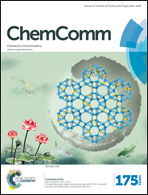A paper-based biomimetic device for the reduction of Cu(ii) to Cu(i) – application to the sensing of Cu(ii)†
Abstract
A biomimetic device for the reduction of Cu(II) to Cu(I) consisting of thioglycolic acid covalently grafted to cellulose paper was developed. The device displays exceptionally fast reducing properties allowing the reduction of Cu(II) in seconds and the formation of deeply colored Cu(I)–SCH2R complexes onto the cellulose paper. This biomimetic and biomaterial-based concept was exploited for the detection of copper in water samples with a limit of detection as low as 2 ppm.


 Please wait while we load your content...
Please wait while we load your content...